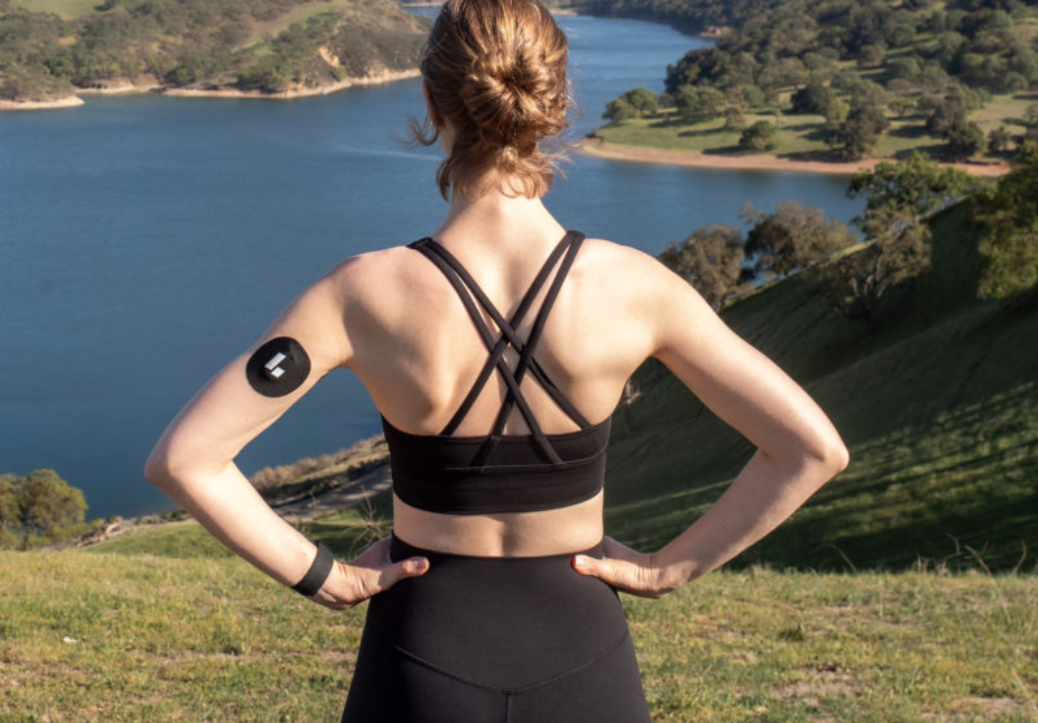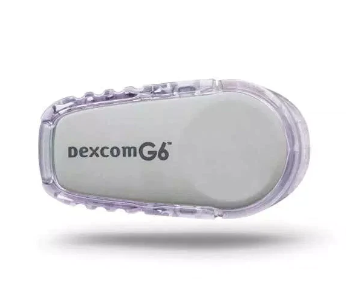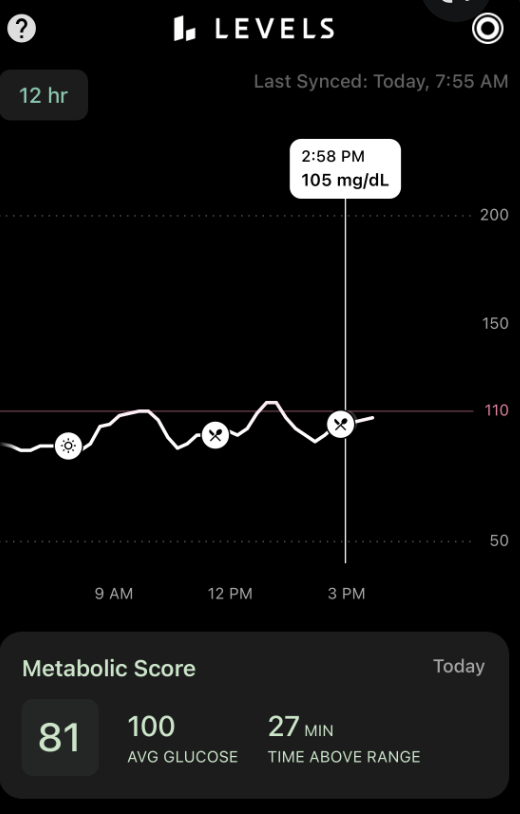Why I Wear a Continuous Glucose Monitor
About three months ago, a friend of mine purchased a continuous glucose monitor (CGM). She isn’t diabetic. Most people might’ve thought: okaaaay, that’s weird. I thought: COOL! So of course, I dove headfirst into podcasts and articles about the impact of glucose regulation. And the further I dug into the health and wellness space, the more it seemed like EVERYONE was wearing a CGM. I had to know what all the hype was. Why care so much about your glucose if you’re not diabetic?
For me, the key term is “metabolic flexibility.” This means that if we’re constantly flooding our body with glucose (carbohydrates like sugar and starch), we train our body to burn glucose for fuel and we never burn the other source of fuel: fat. And we have a near limitless supply of fat stores to burn. But you’ll always burn glucose FIRST, so you have to make sure your body “sees” less glucose to be metabolically flexible. Also, less glucose around means less injury to the cells in your body. Besides diabetes, uncontrolled glucose can increase your risk of heart disease, dementia, and even cancer.
Another curiosity for me was to see how my diet affects the rest of my life, and whether or not glucose plays a role. I wanted to see for myself how the food that I eat impacts my blood glucose levels, and how my blood glucose levels impact everything else – my mood, my energy, my performace, my sleep. Would I even notice anything? I eat pretty healthily at baseline, I’m not overweight, and I LOVE to exercise. I figured I wouldn’t have to change anything. I expected that my healthy living would show that glucose monitor that I had nothing to fear.
Boy was I wrong.
I ordered my CGM through a company called Levels. They’re a tech start-up that built their own app around the glucose data that tells you which foods (or combinations of food) spikes your glucose and which foods don’t. Access to the app was $200 for a one-year subscription, and the CGM was $200 for a 30-day supply. So it’s $400 the first month and $200 per month after that.
Technically, CGMs are class 2 medical devices, which means that you need a prescription to get one. So Levels will ask you some routine health questions and enroll you in a clinical trial so you can get prescribed the device. (As a result, they have one of the largest databases on glucose regulation for non-diabetics.)
Your device shows up as two parts: A plastic disc called a transmitter, which lasts for 90 days, and a sensor, which lasts only 10 days. It’s surprisingly easy and painless to apply the sensor to your body – usually the back of your upper arm. The sensor is attached to you by a thin hair-like filament that samples your blood, and it snaps into the transmitter, which sends information via Bluetooth to your phone. The whole thing is about 2x3 inches around, and it’s sweat-proof and waterproof. I was worried that it would stand out and people would ask about it. Nobody ever has. It's the exact same device that diabetics use.
Levels recommends that you start by eating “normally” the first few days before you start testing or comparing foods. That was a disaster for me. By far the biggest surprise of my Levels experience was how sensitive my body is to glucose. Things I would eat DAILY – like sweet potato, pasta, and even quinoa – would spike my glucose. Levels recommends that your glucose should spike 30 points or less after meals, and my spikes were in the 50s, and even up to 90 points higher than my baseline glucose values. So I adjusted my diet pretty quickly, haha.
The second thing that surprised me was how elevated my “fasting” glucose levels were. Many days I woke up with a fasting glucose level well above 100 mg/dl, which would classify me as pre-diabetic if I’d gotten that test at a doctor’s office. Some days I even woke up with a fasting glucose above 126 mg/dl, which would mean I have frank diabetes. I was absolutely floored. In fact, I was so surprised that I went to the drugstore and bought a $10 finger stick glucose kit to verify the results on my CGM. Much to my dismay, the CGM was accurate. As I later found out, 50% of US adults have either pre-diabetes or Type 2 diabetes, and 90% of pre-diabetics have NO IDEA they have it. WOW. Could I be one of those?
So naturally, I started carb-cutting, and carb-counting. I got rid of things like my sweetened coffee creamer and my beloved nightly ice cream. Since my goal was never weight loss, I substituted things like avocados, nuts, nut milk, and protein powders to make sure I wasn’t cutting calories and losing weight. I tried to keep my daily carbohydrate intake as low as possible.
And it made me feel like crap.
I know everyone’s experience with low-carb eating is different. Lots of people feel energized and love it. Not me. Pretty quickly, my performance on my Peloton bike fell significantly. I was working as hard as I could, but my muscles felt stiff and sore. I just didn’t have enough energy, and I constantly felt fatigued. My glucose numbers were more stable, for sure, but it just wasn’t worth it for me.
That’s when I found Jessie Inchauspé’s @glucosegoddess account on Instagram, and it was a game changer for me. I’ve written about her book Glucose Revolution in another blog, but the point is that you CAN eat carbs and keep your glucose stable. Just try to eat them last, on a full stomach.
So I started applying the “hacks,” like eating carbs last, drinking some apple cider vinegar in water before meals, and walking after meals. My glucose numbers were still stable, and the fatigue faded away. I finally feel like I’ve achieved a healthy balance: eating a diet that gives me energy without sacrificing metabolic flexibility.
So if you’re considering getting a CGM, here are the “pros”:
The ability to “test” foods – the Levels app allows you to compare your glucose graphs from different meals on different days. So you can tell which of your favorite take-out meals is a better choice, or which protein bar doesn’t spike your glucose as much.
Personalized data about how what you ate affects YOU in real-time. My husband also got a CGM, and different foods affect our glucose levels differently.
The ability to get additional testing. Levels offers a “metabolic panel” that tests things your doctor might not normally test – like fasting insulin. It also checks your 3-month glucose average (called hemoglobin A1C) and cholesterol panel, so you can categorize your own personal risk of things like diabetes and cardiovascular disease.
The blog – I love the Levels blog, and you can look it up online without a subscription. It answers questions like, “why does exercise spike my glucose?” and “how does alcohol affect my glucose?” It’s a great resource.
Customer service. Both my husband and I have had occasional issues with sensors that came off or failed. The support email support@levelshealth.com has been amazing and has sent us what we needed without an additional cost.
Most importantly, it gives you autonomy and empowers you to make the lifestyle decisions that are right for you.
Here are some “cons”:
Cost. It’s expensive! Obviously that’s a huge issue. I think it’s worth it to dial in your own personal diet and lifestyle choices. But the cost is definitely a hindrance to access for these devices, since insurance doesn’t cover them for non-diabetics (yet).
Addiction: yes, it IS an addictive product! Logging your food and checking your responses takes time, and it can take away from the joy of just eating whatever you want. I took a break from my CGM when we were Italy for just that reason: I wanted to eat all the pasta. But now that I’m back in a routine, it’s been helpful and informative.
Glucose isn’t everything. Just because it doesn’t spike your glucose doesn’t mean it’s good for you. You can certainly turn a glucose-stable diet into a train wreck by eating only meat, for example, or alcohol. You still have to care about nutrition.
The data is still in its infancy. Since such a small proportion of the non-diabetic uses CGM technology, time will tell how the trends will pan out. Are our glucose levels more out-of-control than we think, like mine was? Who knows!
Anyhow, that’s been my experience with my CGM over the past three months. Despite its limitations, I still think it’s been a very useful tool in my health toolbox. Do you wear a CGM? What has your experience been? I would love to know!






